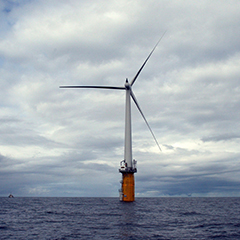The concept of using wind power for offshore oil and gas applications is one step closer to realisation. WIN WIN, a DNV GL-led joint industry project (JIP), is running with the following seven participants: ExxonMobil, ENI Norge, Nexen Petroleum UK Ltd, Statoil, VNG, PG Flow Solutions, and ORE Catapult.
Initial DNV GL studies showed that a standalone wind-powered water-injection system could become cost competitive for various types of applications, particularly for water injection far from the production platform and when costly retrofitting is not an option. DNV GL launched the WIN WIN JIP to help develop the concept further.
“We’ve had a fantastic response from the industry and are very pleased that seven important players from both industries have joined the JIP. Together, they cover the value chain from wind production and operation, to pump manufacturing, to five oil and gas operators,” says Johan Sandberg, Segment Leader – Floating Wind Turbines at DNV GL and the project sponsor.
“We are very satisfied that DNV GL has taken the initiative to form a JIP, and brought on board several of our peers from the oil and gas industry. The overall concept needs maturing up to a point where it can be considered a viable option in field development studies,” says Hanne Wigum, manager for Statoil’s renewables research group.
The project is now in the phase where the technical concept is being developed and the technical feasibility assessed in detail. Two of the main challenges being addressed are the off-grid operation of the system and the reservoir’s response to variable injection rates.
“Once the technical hurdles are cleared, the concept’s economic viability will be analysed using relevant and realistic cases provided by the JIP partners. Initial results are promising, and with the operators on board we are able to test the concept on real cases,” Sandberg continues.
“In parallel with finalizing the initial technical and economic assessment of the concept, we are now thinking about the next steps, both looking for other relevant applications of the system and making sure the WIN WIN concept moves from the drawing board to a prototype and actual realization in a project,” he adds.
Cian Conroy, Offshore Wind Sector Lead for ORE Catapult, says: “Recent advancements and trialling of offshore floating wind prototypes, backed by strong research, suggest there is scope for cost effective floating wind power sooner than many people may have previously thought. This project will help to further accelerate the development and commercialisation of floating wind turbines as a viable technology.”
The JIP has been up and running since the beginning of the year and is scheduled to be completed in the first quarter of 2016.
About DNV GL
As of 12 September 2013, DNV and GL have merged to form DNV GL. Driven by our purpose of safeguarding life, property and the environment, DNV GL enables organizations to advance the safety and sustainability of their business. We provide classification and technical assurance along with software and independent expert advisory services to the maritime, oil & gas and energy industries. We also provide certification services to customers across a wide range of industries. With our origins stretching back to 1864, our reach today is global. Operating in more than 100 countries, our 16,000 professionals are dedicated to helping our customers make the world safer, smarter and greener.


























